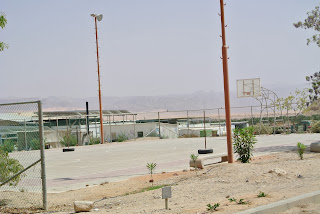 |
| The common courtyard has a little supermarket and the dining hall where the families eat lunch and Shabbat dinner on Friday nights |
 |
| Nancy's house |
 |
| Entrance to the kibbutz |
 |
| New tourist center that was just built outside the gates of the kibbutz |
 |
 |
| Where the bus dropped me off |
I went to meet my fourth cousin and her family this weekend on a kibbutz in the Arava, which is part of the Negev-the southern most desert of Israel. Nancy was so hospitable and generous and she and her two daughters taught me all about their life on a kibbutz. Kibbutz Yahel was founded 35 years ago, by a group of both Israelis and Americans who wanted to live in a small, isolated community. It is a reform Jewish kibbutz, which is unusual, as most kibbutzim are not religious. They have a dairy farm and many many fields, which grow dates and other vegetables in order to make money for the kibbutz as a single entity. Immigrant and refugee laborers travel to these kibbutzim to live and work in the fields although they are not considered members. Yahel is situated on just a few acres in a valley south of the Dead Sea, north of Eilat, and bordered by the mountains of Jordan.
The kibbutz has roughly 300 members who live in charming houses surrounding a common dining hall, mini-market, and synagogue. There is also a pool, tennis courts, and even a small pub for the member's use. The kibbutz almost has a Caribbean feel with its palm trees, dirt paths, and adobe houses and all the children and many dogs run freely within the gated, isolated community.
All of the children go to the same school just a few miles away with children from other kibbutzim in the region. After they graduate high school they all, like most Israelis, go into the army-two years for girls, three years for boys. Afterwards it is very common to travel as a kind of escape from Israel and a celebration of the completion of their service, which is also common of other Israelis who have the means. For example, one of Nancy's daughters, Mihal, and her husband drove up the east coast of Africa for six months before returning to Israel to attend college. Nancy's son is working in Hawaii, but is also planning on returning to Israel and her other daughter Inbal is currently in the army and planning to follow her siblings' footsteps and traveling after she completes her service.
In general, I found the people to be very smart and interesting, and their commitment to the community particularly intriguing. Even the older children who go to college in Tel-Aviv, about three hours away, return home monthly to visit their families and hope to become members of the kibbutz after finishing their degrees. There is something about living the simple life that is very appealing and, despite the isolation, those who grew up on the kibbutz are drawn to return.
Overall, it was a very nice weekend meeting new family and learning so much about yet another angle of life in Israel. Next..Nablus!!!













































